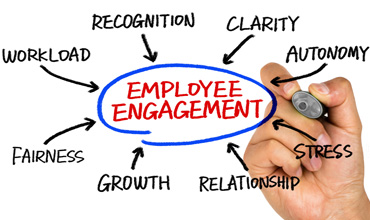Importance of Management Level Employee Engagement in Organizations

Abstract:
Management level employee engagement has
become increasingly popular in the last two decades. The advocated constructive
results of Management level employee engagement make firms to prioritize development
of the culture of engagement within the workplace. Despite so much literature on
the subject, very little has been acknowledged on engagement of management level
workers. It is vital to engage management level workers, given that they have considerable
influence on the way and style the enterprise is managed, and their daily performance
adds on to the relational quality between the organization and its clientele (Fairlie, 2011).
A direct link between worker attitudes and organizational performance has been noted,
in that when an organization’s have a higher performance index, constructive attitude
will be arouse amongst the employees (MacLeod & Clarke, 2009).
Divergent management positions have individual
specifics, and this have to be tackled in the course of engagement development process.
For instance, for marketing and production managers, client satisfaction is a key
issue as they deal with clients with diverse needs, even as for the HR managers,
employee performance is an issue of high priority. It may, therefore, be argued
that management level employee engagement tools are useable for all kinds of managers
regardless of their position in the organization. Based on the above observation,
this paper has been written with the objective of analyzing the importance of management
level employees’ engagement; analyze the level of engagement of management level
workers, and what should be done to promote it (Truss, Alfes, Delbridge, Shantz, & Soane,
2013).
The objective is to evaluate the findings with regards to the extant literature
on management level employee engagement. Knowledge got from the literature review
part of this study, and the outcomes of the study may be utilized by the top level
management of organizations and HR experts, to tackle matters on engagement of management
level workers.
References:
[1]. Easter by-Smith, M., Thorpe, R., &
Jackson, P. R. (2015). Management and Business Research. Thousand Oaks, California:
SAGE.
[2]. Fairlie, P. (2011). Meaningful Work,
Employee Engagement, and Other Key Employee Outcomes: Implications for Human Resource
Development. Advances in Developing Human Resurces, 508–525.
[3]. Garber, P. R. (2012). The Manager's Employee
Engagement Toolbox. Alexandria, Virginia: American Society for Training and Development.
[4]. Klussmann, W. (2009). Philosophy of Leadership
- Driving Employee Engagement in Integrated Management Systems. Hamburg: Diplomica
Verlag.
[5]. Lancaster, G. (2005). Research Methods
in Management: A Concise Introduction to Research in Management and Business Consultancy.
London: Routledge.
[6]. MacLeod, D., & Clarke, N. (2009).
Engaging for success: enhancing performance through employee engagement: a report
to government. London: Department for Business, Innovation and Skills (BIS).
[7]. Markos, S., & Sridevi, M. S. (2010).
Driving Performance and Retention Through Employee Engagement. International Journal
of Business and Management, 89-96.
[8]. Moore, C., Detert, J. R., Linda, K. T.,
Baker, V. L., & David, M. M. (2012). WHY EMPLOYEES DO BAD THINGS: MORAL DISENGAGEMENT
AND UNETHICAL ORGANIZATIONAL BEHAVIOR. PERSONNEL PSYCHOLOGY, 1–48.
[9]. Sakovska, M. (2012). Importance of Employee
Engagement in Business Environment: Measuring the engagement level of administrative
personnel in VUC Aarhus and detecting factors requiring improvement. Aarhus C, Denmark:
Aarhus University.
[10]. Townsend, K., Loudoun, R., & Lewin,
D. (2016). Handbook of Qualitative Research Methods on Human Resource Management:
Innovative Techniques. Cheltenham: Edward Elgar Publishing.
[11]. Truss, C., Alfes, K., Delbridge, R.,
Shantz, A., & Soane, E. (2013). Employee Engagement in Theory and Practice.
London: Routledge.
[12]. Wollard, K. K. (2011). Quiet Desperation:
Another Perspective on Employee Engagement. Advances in Developing Human Resources,
526–537.
[13]. Woodruffe, C. (2006). The crucial importance
of employee engagement. Human Resource Management International Digest, 3 - 5.
[14]. Zelles, R. (2012). Methodologies to measure
and define Employee Engagement. Munchen: GRIN Verlag.

